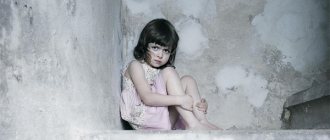.
In modern life, adverse events can easily harm the psyche of children. They develop fears. The diagnosis of children's fears allows us to timely identify the problem and get rid of it.
Childhood fears
Unidentified fear can have both hidden and extreme forms of expression, characterized by a protracted course. All this affects the development of personality, the formation of character and the determination of social roles.
The origin of fears in preschoolers
For various reasons, preschool children become the most susceptible to adverse factors. The number of children with signs of emotional distress is increasing. They become excitable, anxious or aggressive.
The origin of fears can be different. Some of them are observed due to problems and difficulties in the preschooler’s relationship with his parents or with peers. Others may be related to personal experiences. Psychologists believe that the formation of phobic disorders has 2 main theories of origin, which unite all the causes of occurrence.
The first theory is a traumatic factor, the second is a consequence of the threat of repetition of this factor. The characteristics of the mental development of children depend on the reality of the threat after experiencing stressful situations, which resulted in the formation of a fear of a certain stimulus. Affectively heightened perception of danger is part of the defense mechanism. Those children who suffer from fears change their own behavior and react differently emotionally.
Immunity to fears, that is, the absence of an impact on the psyche, is observed very rarely. Psychologists are sure that this is unnatural for the normal development of children. Such problems may indicate problems with expressing emotions, excessive excitability, and even weak self-preservation instincts.
Analysis of drawings.
At school
The drawings turned out to be very diverse. Some children only drew the school, tables and teachers; others only drew their classmates, teachers, what they do during breaks, in an after-school group; still others pictured only themselves in the spotlight.
In drawings on the theme “At School,” the most important thing is how the child mutually positions the figures of his peers and himself. Those children who picture themselves in the center of the group are children with hysterical character traits
Those children who have few or no peers in the picture are children with neurotic reactions. This also reflects problems of understanding with peers. The same applies to drawings on the theme “On the street, in the yard.” If there are few peers in the child’s drawing, then this indicates difficulties in acquiring friendly, stable contacts and excessive care in the family.
Drawings on the theme “Family”.
Children are given the task of drawing everyone with whom the child lives. Exploring fears through drawings.
In the drawings, the order and proximity of the figures and especially the place of the child are of great importance. If a child draws himself between his parents, this indicates attachment to both parents, if close to one of them, this indicates expressed attachment to one parent. Finally, the color scheme shared with one of the adults, in particular the same coloring of the body, indicates a greater degree of identification with him on the basis of gender.
Drawings on the topic “What scary things do I dream about or what am I afraid of during the day.”
The goal for children is to display the most vivid fear. Which one is not explained to the children, each child must choose it himself.
Features of fears in preschoolers
The emergence of fears is directly related to the pathogenesis of the development of neuroses in children and adolescents. It is important to understand the features of their diagnosis. Assessing the actions of irritating factors, as well as the influence of these processes on the formation of personality, will help bring the psyche back to normal. Without knowledge about the age-related dynamics of such problems, the correction of fears will not be effective. It is also important that the appearance of phobic disorders is characterized differently in boys and girls.
Psychologist A.I. Zakharov in his works pointed out the following features of the development of anxiety in preschool children:
- Fears occur more often in girls than in boys between the ages of 3 and 15 years.
- Girls and boys have different natures and directions of fears.
- Boys hide their own anxiety about fears more than girls.
A favorable attitude towards children from parents and social groups and other signs of normalization of life circumstances can lead to them overcoming their fears on their own. Problems disappear with age, but not always. Some are subject to difficulties in personal development, have difficulty adapting, or experience neurotic disorders.
A. Zakharov proposed a system for distributing fears by gender and year, enclosing them in certain characteristics. In total, the scientist’s work described 28 variants of phobias. More than half of them are allocated for preschoolers.
Is there prevention?
Many childhood fears can be prevented. There are simple rules for preventing their development:
provide love and sufficient attention to the baby; eliminate scandals in the family; control children's viewing of television programs; exclude computer games with elements of aggression and violence; do not frighten the child, trying to achieve his obedience; avoid excessive guardianship and excessive severity when raising a child; praise even for small achievements and successes; if you don’t like the dark, leave the night light on; parents should not tell their child about their fears; build communication with the child in a confidential manner so that he shares his problems.
Obsessive fears occur in every third child. Childhood phobias usually disappear without a trace if you treat them correctly and follow the recommendations of a psychologist.
But mothers and fathers need to be prepared for long and difficult work, because the main burden of overcoming the problem of the baby’s fears will fall on their shoulders. The joint efforts of a specialist and parents will definitely have a positive effect and provide the child with peace of mind and self-confidence.
Common types of fears in children
Zakharov’s theories about the peculiarities of the formation of phobic disorders in children are still used by specialists today. According to his classification, preschoolers are classified with 12 to 15 different types of fear. The most common ones are:
- fear of parental death;
- fear of strangers;
- fear of the dark;
- night terrors;
- fear of water, fire or heights;
- fears of cats, dogs or other animals.
No less common are fear of parents, fear of being punished, or fear of doctors and injections. There are many options. A qualified specialist, when starting to correct the fears of preschool children, is obliged to study the clinical picture of the patient.
Night terrors in children
The work involves the use of special techniques, the objectives of which are based on creating a trusting relationship with the patient with inherent emotional contact.
To identify fears, it is important to use a ready-made, proven diagnostic model using special questionnaires or games.
Method
The study involved 72 fourth-grade students at a Moscow gymnasium (35 girls, 37 boys). The study was conducted in November 2005 in the middle of the school day in a quiet environment.
The procedure for administering the school anxiety test was quite standard. The test was administered in groups of no more than 15 people, in writing by a school psychologist with whom the respondents had a friendly relationship. The survey was carried out during school hours.
Age stages of fear formation
Scientists have proven that the occurrence of fears depends on the age of children, as well as the level of mental development. The appearance of deviations in developmental characteristics is a consequence of the emotional sensitivity and suspiciousness of children. Parents also have an influence, who can, with anxiety and overprotection, cause fear of imaginary or real stimuli. This is especially true for girls.
From birth, fear manifests itself at the level of instincts. Under the influence of the surrounding world, he can transform with the perception of “one’s own” and “alien”, “bad” and “evil”, etc. Growing up, children become less dependent on instincts, and their fears become more real, having a certain basis.
Fears in newborns
In newborns, the definition of fears is complicated by developmental features. Scientists are confident that certain signs can only be detected from the age of seven months. The types of anxiety themselves are more often associated with a defense mechanism that manifests itself at the instinctive level:
- fear of a large object approaching;
- fear of loud noises;
- fear of bright light.
During the first year of life, these fears disappear. The child develops a feeling of attachment to his mother, and he is already afraid of losing sight of her. This phenomenon is a consequence of the emergence of an emotional attachment to the mother. In the normal course of life, a newborn gradually outgrows such a problem, increasingly letting go of a loved one from himself.
The child is afraid of strangers
From 8 months of age, a fear of strangers develops. It is associated with an understanding of the principles of “one’s own” and “someone else’s.” Noticing strangers, the child finds signs of their difference from their mother or father. Signs of emerging problems may include:
- poor sleep;
- moodiness;
- excitability;
- anxiety;
- instability of mood.
This affects the formation of personal qualities, adaptive functions and the establishment of character. It is important to provide the child with the most favorable living conditions, to relieve him of stress, long trips, moving, etc.
2-3 years of life
From the second year, children experience less unconscious fear. They begin to actively explore the world, gaining their first life experience. The emergence of fears may be a consequence of these processes. Children at this age may be afraid of:
- sharp sounds;
- pain;
- heights;
- to be left alone.
In the third year of life, children begin to more actively perceive information from their parents. They develop a sense of responsibility for their own actions. Three-year-olds develop a fear of punishment.
Cases of aggression from animals are often affected, which can also cause disorders. This is especially true for dogs. During this period, it is important that children learn to express their thoughts and share their experiences with their parents. The task of adults is related to providing timely assistance to their own, even if some fears are imaginary.
3-5 years of life
Starting from the age of three, the number of fears in children begins to increase. Life in the modern world has its advantages and disadvantages, which the brain activity of children is not able to soberly assess. In the period from 3 to 5 years, the emergence of fears is directly related to the surrounding world and the actions of parents, who are overly concerned or principled. Most often, children of this age are afraid of:
- pain;
- water;
- confined space;
- loneliness;
- transport;
- characters from books, films, etc.
From the age of 5-6, a child begins to understand that he is growing up, just like the close people around him. He may be afraid of both his own death and the loss of his loved ones. Awareness of space and time and the irreversibility of the consequences of these processes can cause the emergence of fear of death.
Fears in older preschoolers
The emergence of fears in children of older preschool age often feeds strength due to the awareness of the social role under the influence of the situation in the family. Various conflicts, illnesses, forced changes in kindergarten, etc., increase the feeling of fear, making it more acute and unpredictable.
Older preschoolers can also feel the first “fruits” of determining their role in society. The first contacts with peers, emotional attachment and feelings of disgust towards aggressive children shape the perception of the world. Some parents do not control their children's free time, allowing them to play computer games, watch films with scenes of violence, etc. This can also cause fears to arise.
The power of imagination
Separately, it is worth mentioning the role of fantasy in perpetuating fears in children. Prolonged experience of fears, their transition into phobias is typical for children who are anxious, suspicious, unconfident, impressionable, pessimistic, dependent and susceptible to influence. It is in such cases that innocent childhood fantasies quickly acquire obsessive chronic features.
And children, especially in preschool age, fantasize for any reason (this is a natural stage of their psychological development): heard a scary fairy tale or horror story from a peer, watched a scary cartoon or movie, read a book with a terrible plot, played a bloody computer game, heard something in the conversation of adults. Even cats fighting in the yard can cause fear.
A developed imagination works continuously. Frightening shadows from a lamp, curtains, blankets, the ominous light of the full moon, mysterious sounds outside the window - these are the colors in which an impressionable child perceives the world. And so his life is filled with ghosts, werewolves, aliens, monsters and monsters...
Basic methods for diagnosing fears
Diagnosis of fears is based on various methods of interaction with the child. Talking about fears is often used, as well as art therapy and play-based exploration. Research with younger preschoolers is carried out using drawing. The child’s task is to portray his own fear.
Today, psychologists use more than 20 different methods for identifying fears. The most common ones are:
- "Fears in the Houses";
- “Fear when I sleep and when I am awake”;
- "My Fears";
- "Drawing of a family."
Puppet therapy is also effective. This technique for identifying children's fears is based on observing children who spend time alone with toys. Routine observation of the child gradually shifts to the intervention of a specialist, who must conduct a diagnostic session in a playful manner.
This technique is especially helpful when knowing the subject that the child is afraid of. Among the toys selected in advance there should be those that embody the fear of the young patient. It is important to come up with a plot in which, while playing, the child will be able to overcome his own fear. The main thing is for the preschooler to realize that he is stronger and more powerful than the object of his own fear.
Fears in the houses
This technique was developed by psychologist M. Panfilova. Its peculiarity is that the diagnostic process reminds children of a game. The preschooler is given two sheets of paper and pencils. On paper he must draw 2 houses of different colors, in which he must “plant” his own fears. The preschooler must place everything that is not scary in one house, and everything scary in the other.
After all the “terrible” fears have been placed in one of the houses, the child is given the task of drawing a lock on its door, the keys to which were lost. Such actions will help the preschooler realize that his fear is securely covered and will not harm him.
Fear when I'm asleep and awake
This technique was created by psychologist Zakharova. It is also based on drawing fears. The psychologist’s task is to give clear instructions to the preschooler. The patient must portray his fear and later verbalize it.
Assignment to draw your fear
This diagnosis is effective in establishing contact with children who suffer from increased anxiety. By talking about his drawing, the preschooler introduces the specialist to his fears. This method has important psychocorrection properties. Discussing the drawing in a playful way allows you to transform internal resources, their direction and character from protection to personal changes of a constructive form.
My fears
This popular technique is also based on drawing. The primary task of the psychologist is an introductory conversation. The specialist establishes contact with the child and learns from him what he is afraid of. The next step is drawing without a given theme.
This technique is effective in diagnosing fears in children of both junior and senior preschool age. Its peculiarity is that the psychologist can analyze the drawing in detail, paying attention to the shape of the depicted object, its individual parts and color.
Family drawing
This technique is often used when a problematic relationship with mother and father is suspected. Problems in the family leave a serious imprint on the child’s psyche, which is why he can change his attitude towards loved ones, occupy a certain place, etc. The methodology itself is built in 2 stages. The first is an image of a family on paper. The second is a patient interview.
Once the drawing is ready, the psychologist begins the survey, which is conducted in a playful way. The following questions are asked:
- Whose family is drawn? (Family of a patient, friend or some fictional character).
- Where are the drawn people and what are they doing?
- Who in the family has what role?
- Which character does a preschooler sympathize with?
- Which character is the saddest?
- Which of the children depicted are punished by their parents and how?
You can also use a fictitious story about a family going for a walk, but there is not enough space in their car for one person. The preschooler should think about who the family would leave at home.
From the responses received, the psychologist receives a sufficient amount of information about the patient’s fears. The specialist has a sufficient picture to choose the right method for correcting the disorder.
Correction methods
How to deal with childhood fears? This question has always been relevant due to the prevalence of the problem among children of all ages. The main task in the treatment of phobias is to bring them into the light, to find out what scares the child.
First, you need to determine the type of fear - pathological or physiological. This can only be done by a specialist in child psychology, having first talked in detail with the parents and the child.
Secondly, it is important to find out the cause of this disorder. Each type of phobia has its own causes and manifests itself differently in each child.
As they grow older, one type can transform into another, so correcting children's fears requires a careful psychological examination of the baby and individual selection of suitable techniques.
Fairy tales
To overcome children's fear at 2-4 years old, you can tell your child fairy tales where he is the main character. During the course of the story, he has to deal with exactly what is causing the disorder (a monster in the dark, a closed room, water, fire, the absence of parents nearby). The hero overcomes all difficulties and defeats his opponents. Such stories help children feel more confident and become braver.
Games
To overcome fear of the dark in young children, parents can practice playing hide and seek. The child must find the doll first in a lighted room, then in the dark. A toy found in the dark should be rewarded. The fear gradually fades away, giving way to the desire for parental praise and treats.
Children's fear of death, which usually arises at 5-6 years old, can be acted out in the form of a puppet show, where death is presented as weak, funny or unreal, made up. The main character successfully drives her away. You can also defeat characters from nightmares in a playful way.
Drawings
Treatment of childhood fears using drawing is very effective. The child must draw his nightmare in a funny way. A sketch of what frightens in a transformed form has a positive effect on the child’s psyche: he was evil, he became kind and safe. Sometimes children enjoy drawing the object of their fear in a defeated form.
Music
Calm, quiet classical music helps relieve nervous tension. In an unobtrusive form, you can invite your child to listen to it before bed, while being next to him, quietly stroking his head and saying kind words.
Dancing
Dancing classes give a positive emotional mood and promote psychological relaxation. The baby learns rhythm, communication, calms down, begins to feel stronger and freer.
Aromatherapy
The use of essential oils that have a calming effect helps relieve nervous tension. You can use medicinal plant oils in the bedroom using an aroma lamp, or adding them to a warm bath, which will calm your baby well before bed.
These can be lavender, mint, and sage oils. But before using them, you need to consult your doctor and make sure you are not allergic to the product you are using.
Color therapy
The children's room should be decorated in calm colors; toys in bright colors - red, black, orange - should be purchased in limited quantities. When choosing clothes for your baby, you should give preference to things in green, blue or yellow colors.
Other techniques
Working with children's fears also includes modeling from clay and plasticine, especially if children do not like to draw, are indifferent to music and are persevering. You can ask them to create a defeated nightmare - to make what frightened you in a dream funny and defenseless.
In some cases, making a cardboard mask of a fairy-tale character, who is the source of fear, helps. Parents can put it on and playfully and affectionately talk to their child and play with him.
Identifying an anxious child in a group
Work with preschoolers can also be carried out in group classes. One of the ways to identify anxious children is to determine signs of fear according to the system created by G. Lavrentieva and T. Titarenko. The questionnaire includes 20 main points, each of which requires specific supervision of a specialist over children.
The specialist assesses whether a particular preschooler can:
- Play without getting tired.
- Complain when he has nightmares.
- Be subject to frequent mood changes.
- Have problems with appetite.
- Hold back tears during conflicts.
- Have problems sleeping.
To indicate the answers to the points, a table is built with the names of the children. The specialist puts a “plus” or “minus” next to each question. The total number of characters in the column of each test taker is counted. The level of anxiety determines the number of “+”:
- 1-6 – low;
- 7-14 – average;
- 15-20 – high.
This technique is ineffective for individual diagnosis. Its task is to identify anxious children, and not to find out the specifics of their fears.
How to identify separation anxiety in a preschooler
Examination of younger schoolchildren, as well as preschoolers, about their adaptability in a social group often shows that children have a fear of separation from their parents. The main feature of such anxiety is that the child overcomes the feeling of his own attachment to loved ones, which has a beneficial effect on his personal development. For the child himself it is painful.
Psychologists P. Baker and M. Alvord created an effective method for identifying children suffering from fear of separation from loved ones. Scientists have established signs by which every child psychologist can identify the sufferer:
- Constant frustration of the child, his sadness after his parents leave.
- Worry about an adult.
- Constant worry that his family won't take him home.
- Systematic refusal to go to kindergarten.
- A systematic fear of being alone.
- Fear of falling asleep alone and nightmares.
You should also take into account the presence of complaints in children regarding their health status. Fear of separation and its impact on the psyche of a preschooler can cause signs of various diseases. It is important to identify them and record them in a timely manner.








